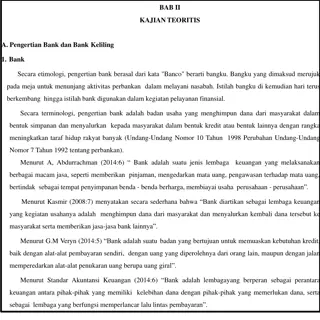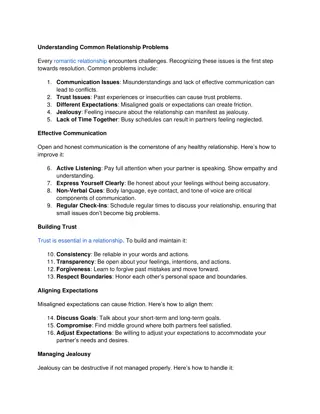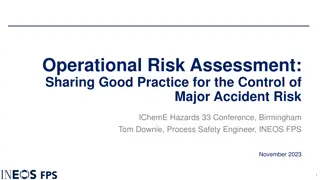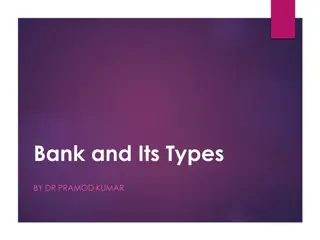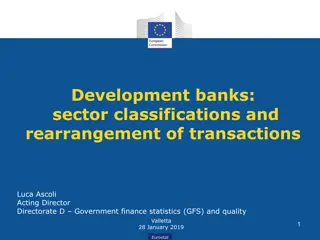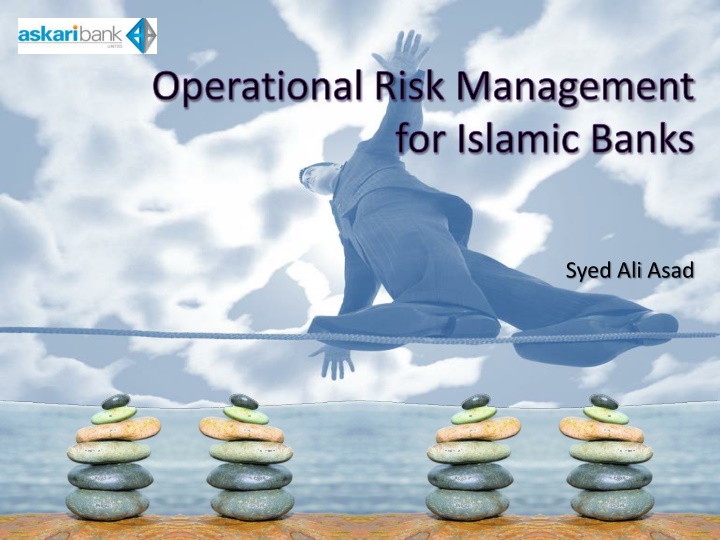
Enhancing Operational Risk Management in Islamic Banking
Explore the complexities of operational risk management in Islamic banks through the lens of Syed Ali Asad's insights. Delve into the intersection of risk management and Islamic principles, understanding the unique challenges faced by Islamic banks, and the various types of operational risks they encounter. Gain a comprehensive view of operational risk, including process, people, system, and external risks, and discover strategies to mitigate these risks effectively.
Download Presentation

Please find below an Image/Link to download the presentation.
The content on the website is provided AS IS for your information and personal use only. It may not be sold, licensed, or shared on other websites without obtaining consent from the author. If you encounter any issues during the download, it is possible that the publisher has removed the file from their server.
You are allowed to download the files provided on this website for personal or commercial use, subject to the condition that they are used lawfully. All files are the property of their respective owners.
The content on the website is provided AS IS for your information and personal use only. It may not be sold, licensed, or shared on other websites without obtaining consent from the author.
E N D
Presentation Transcript
Operational Risk Management for Islamic Banks Syed Ali Asad
Risk Management and Islam And he said, O my sons, do not enter (the city) all of you from the same gate, rather, enter from different gates. And I cannot help you in any way against (the will of) Allah. Sovereignty belongs to none but Allah. In Him I place my trust, and all those who trust should trust in Him alone. (Yusuf: 67)
Defining & Understanding Operational Risk Operational risk is the risk of loss resulting from inadequate or failed internal processes, people, and systems or from external events. -Basel Committee on Banking Supervision Islamic Banks (IBs) are also exposed to risk related to Shariah non-compliance, reputation, and fiduciary responsibilities. 4
Defining & Understanding Operational Risk Process Risk: Risks related to the execution and maintenance of transactions, and the various aspects of running a business, including products and services. People Risk: The risk of a loss intentionally or unintentionally caused by an employee i.e. employee error, employee misdeeds or involving employees, such as in the area of employment disputes. This risk class covers internal organizational problems and losses. System Risk: The risk of loss caused by a piracy, theft, failure, break down or other disruption in technology, data or information; also includes technology that fails to meet business needs. External Risk: The risk of loss arises due to damage of physical property/ assets from the natural or non natural causes. This category also includes the risk presented by actions of external parties, such as the perpetration of fraud, or in the case of regulators, the execution of change that would alter the firm s ability to continue operating in certain markets
Defining & Understanding Operational Risk 6
Defining & Understanding Operational Risk 7
Defining & Understanding Operational Risk March 17, 2025 8
Defining & Understanding Operational Risk Other Risks Market Risk Operational risk Credit Risk 9
Defining & Understanding Operational Risk What risks are we talking about?? A loan goes bad! Bank suffers losses due to adverse interest rate movement. A customer withdraws money incorrectly transferred to his/her account 10
Defining & Understanding Operational Risk More than 80% of our Credit risk is really just Operational risk. Senior Risk Officer, Large German Bank 11
Defining & Understanding Operational Risk Causes of Op Risk Internal fraud External fraud Employment practices and workplace safety Clients, products and business practices. Damage to physical assets. Business disruption and system failures Execution, delivery and process management 12
Basel II Evolution of Ops Risk 1988 Capital Accord Too simplistic Subject to manipulations Encouraged more risk taking Leading banks, using sophisticated models realized that they were over capitalized and lobbied for a more risk sensitive capital framework. 13
Basel II Evolution of Ops Risk The Basel II Accord Basel II is based on the fundamental principal that risk capital should be based on level of risk (i.e., risk sensitive). Incentive: Requiring banks to hold capital based on their actual level of risk would give banks an incentive to reduce their level of risk Lessons from past experience (in market risk): risk measurement improves risk management. 14
Basel II Evolution of Ops Risk Basel II Three Pillars Minimum Capital Requirements Supervisory Review Market Discipline Providing a flexible, risk-sensitive capital management framework 15
Basel II Evolution of Ops Risk Minimum Capital Requirement Risk-weighted Exposures Market Risk Credit Risk Operational Risk Risk of direct or indirect loss resulting from inadequate or failed internal processes, people and systems or external events Potential that a bank borrower or counterparty will fail to meet its obligations in accordance with agreed terms Risk of losses in on and off balance sheet positions arising from movements in market prices No Change New element added Major Changes 16
Basel II Evolution of Ops Risk PILLAR 2 PILLAR 1 Supervisory Review Minimum Capital Requirements Balance the flexibility and freedom given to banks PILLAR 3 Definition of Capital Risk Weights Market Discipline Operational Risk Credit Risk Market Risk Advanced Measurement Approach Standardized Approach Internal Ratings Based Approach Asset Basic Indicator Approach Standardized Approach Securitization Alternate Standardized Approach Foundation Approach Advanced Approach Standardized Approach Internal Ratings Based Approach 17
Basel II Evolution of Ops Risk Target for leadings banks Minimum for large banks Minimum for all banks Standardized Basic Indicator Advanced Based upon Loss Distribution Approach. Scenarios or Risk Drivers & Controls Based upon an institutional Gross Income Alpha Based upon Business Line Gross Income Beta But also requires adherence to a set of Sound Practices 18
Basel II SBP Guidelines Basic Indicator Approach Under BIA the capital charge for operational risk is a fixed percentage of average positive annual gross income of the bank over the past three years. Negative or zero income to be excluded from the calculations The charge may be expressed as under 21
Basel II SBP Guidelines Basic Indicator Approach Gross income is defined as the sum of net interest income and net non-interest income and shall be arrived at before accounting for: (i) Provisions, including those for credit impairment; (ii) operating expenses (iii) realized profits/ losses from the sale of securities (iv) extraordinary items, (v) income derived from insurance. No qualifying criteria but banks are expected to follow SBP guidelines on risk management. 22
Basel II SBP Guidelines The Standardized Approach banks divided into eight business lines: corporate finance, trading & sales, retail banking, commercial banking, payment &settlement, agency services, asset management, and retail brokerage Within each business line, gross income to serve as a proxy for the scale of business operations and thus the operational risk exposure The capital charge for each business line is calculated by multiplying gross income by a factor (denoted beta) assigned to that business line. The total capital charge is calculated as the three-year average of the simple summation of the regulatory capital charges across each of the business lines in each year. 23
Basel II SBP Guidelines The Standardized Approach The total capital charge is calculated as the three-year average of the simple summation of the regulatory capital charges across each of the business lines in each year. In any given year, capital charges (resulting from negative gross income) in any business line may offset positive capital charges in other business lines without limit. However, where the aggregate capital charge across all business lines within a given year is negative, then the input to the numerator for that year will be zero. The total capital charge may be expressed as: K TSA = { years 1-n max[ (GI1-8 x 1-8),0]}/n Where: KTSA = the capital charge under the Standardized Approach GI1-8 = annual gross income in a given year, as defined above in the Basic Indicator Approach, for each of the eight business lines 1-8 = a fixed percentage, as given in table on next slide 24
Basel II SBP Guidelines The Standardized Approach Business Lines Corporate finance Trading and sales Retail banking Commercial banking Payment and settlement Agency services Asset management Retail brokerage Beta Factors 18% 18% 12% 15% 18% 15% 12% 12% 25
Basel II SBP Guidelines The Alternative Standardized Approach Under the ASA, the operational risk capital charge /methodology is the same as for the Standardized Approach except for two business lines retail banking and commercial banking. For these business lines, loans and advances multiplied by a fixed factor m replaces gross income as the exposure indicator. KRB = bRB x m x LARB Where KRBis the capital charge for the retail banking business line bRBis the beta for the retail banking business line LARB is total outstanding retail loans and advances (non-risk weighted and gross of provisions), averaged over the past three years and m is constant the value of which is 0.035 26
Basel II SBP Guidelines The Alternative Standardized Approach Under the ASA, banks may aggregate retail and commercial banking (if they wish to) using a beta of 15%. Similarly, those banks that are unable to disaggregate their gross income into the other six business lines can aggregate the total gross income for these six business lines using a beta of 18%, with negative gross income treated as described above 27
Basel II SBP Guidelines TSA Qualifying Criteria BoD oversight. Separate Operational Risk management function. Tracking ops loss data System of reporting ops risk exposure Well documented ORM, with policies and procedures. Periodic review to validate the ORM Regular review by external auditors. 28
ORM Principles for Islamic Banks Shariah Compliance - SBP , Bank s Own Shariah Advisor Reputation & Perception Risk Fund Providers , Customers Fully Compliant at all times in all activities Shariah Compliant Contract Documentation Shariah Compliance Reviews Assess actual as well as probable loss of income due to Shariah non-compliance Risk Management Guidelines for Islamic Banking Institutions Islamic Banking Department, State Bank of Pakistan
ORM Principles for Islamic Banks Fiduciary Risk Conflicting Roles Policy to Manage different and potentially conflicting roles Adequate and Timely disclosure Risk Management Guidelines for Islamic Banking Institutions Islamic Banking Department, State Bank of Pakistan
ORM Principles for Islamic Banks Shariah compliance risk - The risk that arises form Islamic banks failure to comply with the Shariah rules & principles determined by the Shariah Advisor or the relevant body in the jurisdiction in which Islamic banks operate Fiduciary risks - The risk that arises from the Islamic banks failure to perform in accordance with explicit and implicit standards applicable to their fiduciary responsibilities
Assessing Operational Risk Exposure Required Process of Continuous Risk Assessment, Monitoring and Reporting Risk Identification Control Assessment Reporting Mitigation Planning & Execution Likelihood and Severity Measuring/ Monitoring 32
The Process Risk Identification Assessment of Control Framework Risk Likelihood/Severity Assessment Measurement & Monitoring Reporting Mitigation 33
The Tools Control and Risk Self Assessment Key Risk Drivers and Indicators Loss Data Issue and Event Data Audit and Compliance Reports Scenario Analysis 34
Categorizing Operational Losses Event based categorization BIS framework is designed to be event based approach. While the risk universe consists of three independent dimensions; causes, events, consequences. It s more logical to look at ops losses in a cause/effect matrix framework. Such an approach helps evolve better, valid and consistent controls 35
Categorizing Operational Losses CONSEQUENCES EVENTS CAUSES Inadequate segregation of duties Legal Liability Internal Fraud Regulatory, Compliance & Taxation Practices Insufficient training External Fraud EFFECTS Monetary Losses Less of Damage to Assets Lack of management supervision Employment Practices & Workplace Safety Restitution Clients, Products & Business Practices Loss of Resources Inadequate auditing procedures Damage to Physical Assets Write-down Inadequate security measures Business Disruption & System Failures OTHER IMPACTS Forgone Income Execution, Delivery & Process Management Reputation Business Interruption Poor systems design Poor HR policies 36
Managing Ops Risk An operational risk framework 37
Managing Ops Risk An operational risk framework operational risk strategy comprises both the top-down process of capital allocation and clear guidance for the bottom-up processes of risk identification, assessment, management, reporting and supervision, and governance arrangements that constitute the management framework. Setting the risk tolerance/risk appetite Bottom up and top down approaches. 38
Managing Ops Risk Organizational Structure Two key goals need to be reflected in an organizational structure for operational risk: The agreement that operational risk cannot be confined to specific organizational units (unlike market risk) but remains largely the responsibility of line managers and some defined special or support functions (such as IT, HR, legal, internal audit, or compliance) The division of duties among management, an (often to be established) independent risk management function, and internal audit. 39
Managing Ops Risk March 17, 2025 40
Basel II - Challenges & pitfalls Challenges Organizational Sponsorship Business Line Buy-in and Resources Coordination with Existing Control Initiatives Development of Loss Databases Well-Designed Methodologies and Models Access to Appropriate Information and Reporting Mistaking Operational Risk for Market or Credit Risk 41
Basel II - Challenges & pitfalls Pitfalls Waiting for the regulators to provide detailed guidance and lay out an implementation road map Failing to make the link between information, technology, risk management and the business Attempting to build a Basel II infrastructure without data and technical architecture road maps Underestimating the magnitude of cultural change that Basel II requires 42
Operational Risk Management Conclusions Management not Measurement Imprecise science Integrate measurement into Operational Risk Management framework Use data to make informed decisions Control framework Evaluate mitigation Prioritise corrective action Low frequency/High impact events drive operational risk capital!
THANKS! 44

